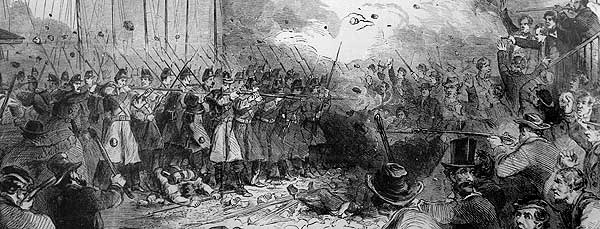| Pratt Street Riot | Baltimore Bastille | Habeas Corpus | Coast Guard | Garrison Flag | Timeline | All Photos |
Pratt Street Riot

Background
Following the secession of the southern States and the bombardment of Fort Sumter, President Abraham Lincoln called for 75,000 men to be raised from the militia of the states in order to put down the rebellion. These troops were to be transported to Washington, D.C. so that they might protect the Capitol. At this time, the most efficient means to transport such large numbers of men was by rail, and the only routes to Washington passed through Baltimore.Marylanders were divided in their sympathies. While many disliked the idea of secession, they felt that it was a state's right to secede from the union if it chose to. Many also felt that Maryland should not permit troops to pass through the state to attack a sister state, and others mistrusted the President's intentions, suspecting that the troops would be used to force Maryland to remain in the Union.
The Riot
On April 19, 1861, only five days after the surrender of Fort Sumter, the situation in Baltimore exploded into violence. The 6th Massachusetts infantry arrived at the President Street Station and began the process of changing trains. The cars were disconnected and pulled by horses down Pratt Street to Camden Station. As the process continued, a crowd gathered and with each moment it became more and more unruly. All but two of the cars had been transferred when the crowd blocked the tracks with timbers and anchors.The two cars returned to the President Street Station and the soldiers disembarked to the howls and jeers of the mob. The troops then marched back down Pratt Street, led by a man carrying a rebel flag, and followed by the mob. At Gay Street some of the mob began tearing up paving stones and throwing them at the soldiers. Other men were seen brandishing pistols and muskets. Someone fired a shot.
The frightened officers ordered the troops to fire into the crowd. This angered the mob further, and they began to attack the soldiers with considerable ferocity. Citizens threw stones and bricks and fired shots at the soldiers. The soldiers returned the fire. Rioters, soldiers, and innocent bystanders fell dead and wounded. The Mayor bravely attempted to stop the battle without success. Then the police arrived.
Marshal Kane put his policemen between the two groups and escorted the troops to Camden Station where they boarded the train and left Baltimore. The Pratt Street Riot was over. The riot resulted in the first casualty list of the war. Eight rioters, one innocent bystander and three soldiers were killed, twenty-four soldiers and an unknown number of civilians wounded.
Its Effect
Baltimore quickly felt the effects of the riot. The Governor and Mayor called out the militia to prevent further bloodshed. When a threat was made against Fort McHenry, one of the militia units was sent to help the U.S. Army defend it. Knowing that there were secessionists in the militia ranks, the commander of the Fort accepted the help on the condition that the militia could come no closer to the Fort than the Catholic chapel a half mile from the Fort or he would fire on them.In May, less than a month after the riot, General Butler and the 6th Massachusetts entered the city and built earthworks on Federal Hill. Cannon were placed in the works so that they could be fired on the city. Civilians who had demonstrated secessionist sympathies were arrested and taken to Fort McHenry, where they were held without charge. Major Morris, the command officer at Fort McHenry, suspended the Habeas Corpus privileges of those prisoners. Baltimore fell under military rule.
Finally, in June, 1861, Maryland voted on secession. By that time Maryland was an occupied state, and the choice no longer existed.
|
The despot's heel is on the shore, Maryland! His torch is at thy temple door, Maryland! Avenge the patriotic gore That flecked the streets of Baltimore And be the battle queen of yore, Maryland, My Maryland! James Ryder Randall |